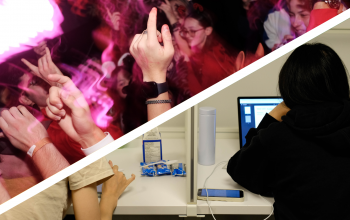What does Luce say about Catholic art?
Carina Mercado, Opinions Editor
St. Michael’s College is no stranger to Catholic art. Depictions of St. Michael the Archangel grace the campus in various forms, ranging from classical to modern, and in sizes both monumental and modest. Even Dante Alighieri stands immortalized with a statue near Teefy Hall. Over two millennia, Catholic art has borne witness to the evolution of faith and tradition. But what does the 21st century hold for this rich artistic heritage?
Regardless of your faith, the trajectory of Catholic art in the modern era deserves attention. The Vatican’s latest creation, designed with Generation Z and Generation Alpha in mind, is a bold testament to this evolution.
Meet Luce, the official mascot for the 2025 Vatican Jubilee. She’s the brainchild of Simone Legno, Italian founder of the globally beloved brand Tokidoki. Yes, that Tokidoki—the brand that captured hearts in the mid-2000s with whimsical designs of unicorns, ice cream, and playful characters on bags and toys. Before Luce, Tokidoki evoked childhood nostalgia for many of us.
Archbishop Rino Fisichella explained that Luce, designed in a popular contemporary art style, aims to be an accessible and engaging symbol of pilgrimage for today’s youth. As a student of the Christianity and Culture program at St. Mike’s, I believe Luce is a triumph of modern Catholic art. Discovering her sparked a question in my mind: is this the same feeling Renaissance pilgrims had upon seeing the Sistine Chapel?
Luce is a vibrant character. With her blue hair, yellow jacket (evoking the Vatican flag), staff, muddy boots, and rosary, she symbolizes perseverance through life’s storms. Her story extends to a loyal dog named Santino and friends Fe, Sky, and Xin, who wear matching raincoats. Whether viewed as a religious symbol or not, Luce’s charm is undeniable. Her design evokes the nostalgia of beloved “chibi” characters like Sanrio or Tomodachi while effectively connecting with younger audiences through storytelling.
One of Luce’s standout moments is her depiction with Mary, the Mother of Jesus. This artistic pairing invites reflection on the portrayal of Mary throughout Catholic history.
Artistic depictions of Mary, especially with children—whether the infant Jesus or others—are deeply rooted in Catholic spaces. From school halls to homes and churches, these images have profoundly shaped Catholic identity. Even ex-Christians I’ve spoken to often retain a fondness for Mary, a testament to the enduring impact of her artistic portrayals.
Historically, depictions of the infant Jesus leaned toward the masculine and mature, symbolizing theological perfection. Whether seated on Mary’s lap offering a benediction or portrayed as an infant-sized adult, his image has evolved over centuries to align with anatomical realism. In contrast, Mary’s representation has remained remarkably consistent.
From Byzantine mosaics to Renaissance frescoes, Orthodox icons, modern art, and even Islamic representations, Mary’s maternal theme transcends cultural boundaries. Catholic depictions emphasize her virtues of piety and motherhood, whether in moments of joy, like the Nativity, or sorrow, like the Crucifixion. For many Catholic children, the comforting presence of Mary was understood long before they could read, thanks to the art surrounding them.
Tokidoki’s rendering of Luce alongside Mary continues this artistic lineage. Mary appears serene and comforting, yet her timeless maternal essence is retained even within Tokidoki’s playful, vibrant style. This depiction reaffirms Mary’s role as a symbol of guidance and protection while embracing a visual language that resonates with today’s youth.
Luce’s interaction with Mary places her within the broader narrative of Catholic art. Just as Renaissance artists adapted classical techniques to illuminate theological truths, and Byzantine icons used abstraction to evoke the divine, Tokidoki adopts pop-cultural aesthetics to engage digital-native generations.
Through Luce’s muddy boots and Santino’s companionship, the artwork metaphorically portrays Mary’s enduring role as a source of hope and comfort during life’s storms. For younger audiences, it introduces Mary in a fresh yet familiar way, ensuring her relevance while preserving her sacred image.
Ultimately, this collaboration between Luce and Mary exemplifies the adaptability of Catholic art. It underscores the Church’s commitment to storytelling through evolving mediums, all while remaining rooted in a rich, unbroken tradition of imagery that inspires faith and fosters connection.
Photo Credit: Tokyo Weekender




